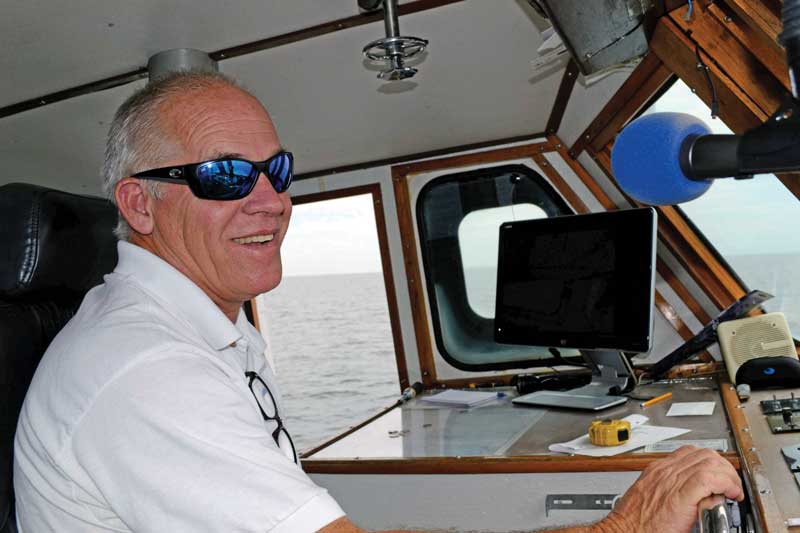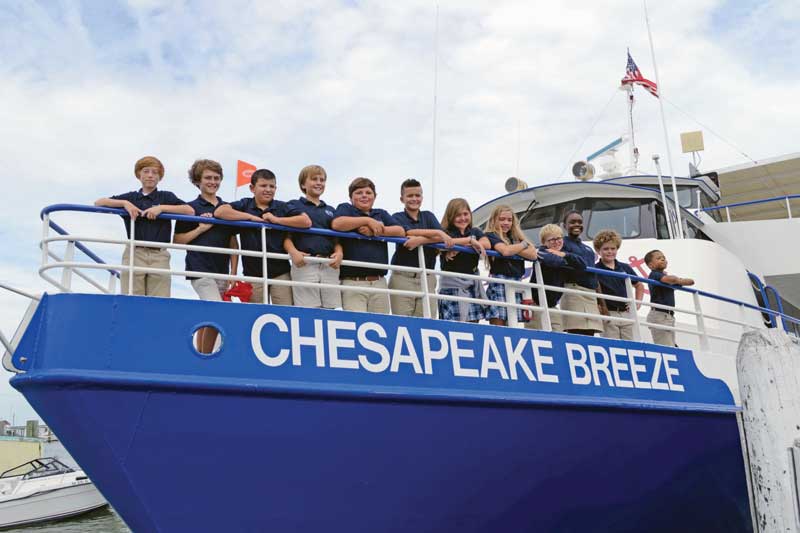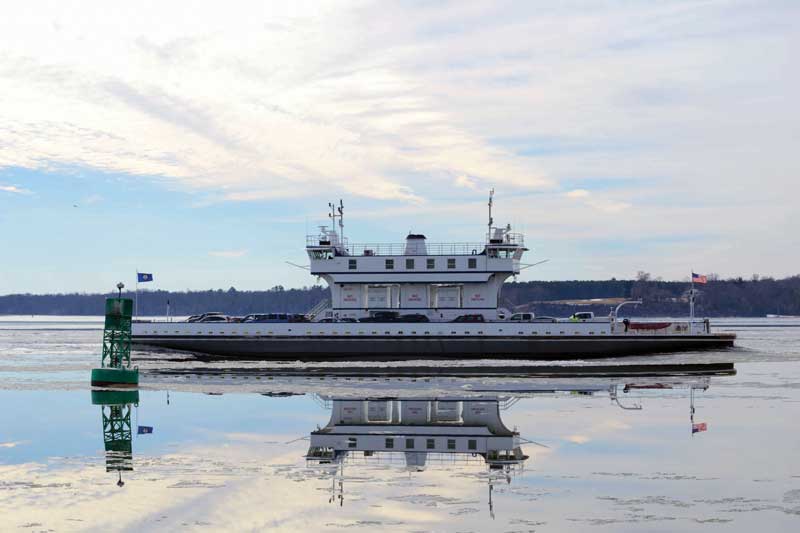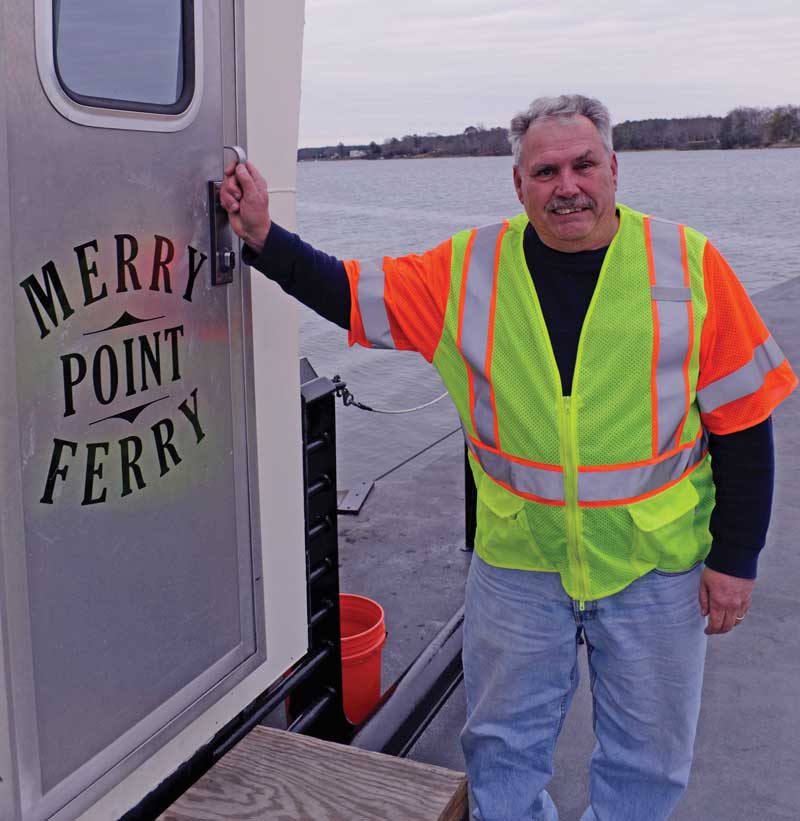Ferry travel, whether part of a school field trip, a quest for crab cakes, or a need to get to the other side has long been a central part of life on the Chesapeake Bay. Want a quick “boat fix” during the winter when your own boat is on the hard? Ride a ferry. Need to get to work but there’s a river in the way? Ride a ferry. Or perhaps you simply want to go back to a time when people rode the “water ladies” and chatted with their fellow travelers. Well, you know the answer.

In the Beginning
Chesapeake Bay ferries have a rich history dating to the early English settlers. Records from 1634 show that the Bay’s first ferry transported passengers and goods across King’s Creek, near modern-day Cape Charles, VA. The English courts allowed its owner, William Ward, to charge a fee. If you didn’t pay the ferryman, Mr. Ward could seize your property.
In 1702, Virginia’s General Assembly established public ferries to “quickly transport troops across rivers and creeks in time of danger.” Ferry owners had to provide free passage for county sheriffs, military officers, and parish priests—but only on Sundays. Within a few years, ferries were traversing the mouth of the Bay from York County, VA, to Northampton on the Eastern Shore. Tobacco production there was exploding and helped drive the need for commercial ferries. The cost to transport a “hogshead” of tobacco, a wooden barrel filled with about 1000 pounds of tobacco, was about 15 shillings—the same as the fare for a man or horse. (No mention of how much a woman had to pay.)

But passengers needed more than just the required fare. Wrote one colonist, “The principal qualification of any traveler is to be ready, at every stage of the journey, to enter the Eternal Mansion or Resting Place.” Over the years as deeper draft vessels, called chaloupes, sailed the Bay, people and livestock would transfer to shallower boats or “punts” to go up the creeks. Owners would force their horses to jump from one boat to another. Not every horse made it; broken legs were common.
The Revolutionary War greatly increased the risk for ferry travel… and the cost. Fares went from six to 20 pounds for a single passenger. Obviously, few people traveled with those rates. But when the war ended, travel by ferry resumed in earnest from Portsmouth, VA, to the Eastern Shore. By 1800, ferries were moving loads of goods, people, and livestock. They were frequently captained by enslaved men. Said one ferry owner to Virginia’s General Assembly, “Slaves proved most able and skillful pilots and expert hands. They were expert watermen.”
All in the Family
Back in colonial times, ferry franchises continued for generations and it’s still true today. Captain Linwood Bowis and his wife, Dorolena, have been operating their company, Tangier Island Cruises for decades, ferrying passengers to and from Tangier Island. Captain Bowis has been driving their flagship, the Chesapeake Breeze, for more than 40 years. “I estimate that I’ve brought more than 400,000 visitors to the island,” he says. The past couple of years have been hard on business because of the pandemic, especially for school and group tours. But he’s looking forward to a great 2022 when the ferry starts running again for the season this May.

“I have a good time when I see other people having a good time,” he explains. Bowis is more than just the driver. Part historian, part tour guide, he enjoys sharing his knowledge of the island with his passengers. With family and a bit of his soul on both shores, he “knows the people, their problems, and their joys,” he explains.
The Chesapeake Breeze departs Buzzard’s Point Marina in Reedville, VA, at 10 a.m. and arrives around 11:30 a.m., perfect timing to grab lunch at Lorraine’s or the Four Brothers Crab House. Then it’s off to explore the island on foot or rent a golf cart from a local resident to visit a few unspoiled beaches. For day trippers, the ferry returns around 2:15 p.m. There are a few options for an overnight stay; but just a few.
Tangier has been in the news a lot lately as the island inexorably loses land from erosion and rising sea levels. Some estimates have the island uninhabitable by 2050. And that continues to put pressure on the 435 current residents there. “I know these people on Tangier and can see the concern in their eyes,” Bowis says sadly. So, every year, from May to October, he shares “his” island with as many people as possible. Because no one knows how long he can.
For more information on traveling to Tangier Island, visit tangiercruise.com.

Get Me to the Hospital on Time
What is it about the Jamestown-Scotland ferry?
Since 2015, three baby girls have been born while their parents were trying to get to a Williamsburg, VA, hospital on the other side of the James River. (Talk about cutting it a bit close!) All three families had safe and happy outcomes, no small thanks to the professionalism and care of the ferry’s crew.
The Jamestown-Scotland ferry made its first run back in 1925 on a boat called the Captain John Smith. The first vessel to transport cars across the James River, it could hold 16 Model A cars. The name, Scotland, refers to the Scotland Wharf which is on the south side of the river. Today, the ferry system is an important connector for many families in rural Surry County. Run and managed by Virginia’s Department of Transportation (VDOT), it is a critical link to transport employees to the nuclear power plant just across from Jamestown.

The fleet’s four boats and nine captains run 24 hours a day, every day of the year. Annually, they carry almost one million cars, more than two million passengers, and thousands of bikers, truckers, and motorcycle riders—not to mention the occasional expectant mother. There is no charge—except to Virginia taxpayers. In 2019, the Powhatan, the newest ferry to enter the line, replaced the 82-year-old, long-serving Virginia. The Powhatan can ferry 70 cars at a time, greatly expanding service.
During the winter, the ferries may have to act as ice breakers. And in the summer, tourists go back and forth, many just to get a good view of Jamestown Settlement, the recreated village, and Historic Jamestowne, the original 1607 site where English settlers first landed. Passengers are welcome to leave their cars, talk to the crew, and enjoy the view.
Although building a bridge to connect the two shores of the James River has been considered over the years, the ferry crew isn’t worried about being replaced. The cost and geography of the James River make building a bridge impractical.
But that hasn’t been the case on other parts of the Bay. The Chesapeake Bay Bridge-Tunnel (CBBT) connects the Virginia capes across the mouth of the Bay. Opened in 1964, the CBBT was named one of the “Seven Engineering Wonders of the Modern World.” It put the Little Creek-Cape Charles ferry out of business which once made 90 runs each day.
Another bridge across the Bay also disrupted ferry service—the Gov. William Preston Lane Jr. Memorial Bridge, commonly called the Chesapeake Bay Bridge. It connects Annapolis and the Eastern Shore and opened in 1952. That same year, the ferry John M. Dennis, on its final run, “accidentally” rammed the bridge. It did no damage. In a press account that year, the ship’s 34-year veteran purser on the Dennis’s final run lamented, “You have to give way to progress. But you can’t sit down and talk to your friends on a bridge.”
A Ferry to the Past
In Greek mythology, Charon is the ferryman who transported the souls of the newly departed across the River Styx. Well, the western branch of the Corrotoman River in rural Virginia is not the River Styx and Dennis Snader is definitely not Charon. Dennis is a retired ferryman who joyfully brought living souls back and forth on the Merry Point cable ferry up in Lancaster County, VA. In the process, he and the current operators are preserving more than 170 years of history.

The ferry began running back in 1847 during the steamboat era and Snader noted that there used to be a general store at the ferry and steamboat dock. Horse and buggies would cross the river and then load their goods on the steamboat. The ferry hasn’t changed much except that it now transports up to four cars at a time instead of horses. Virginia’s Department of Transportation continues to manage both the Merry Point and Sunnybank ferries. There is no fee to cross, but the trip itself is priceless.
Cable ferries basically pull themselves along a submerged cable, lifting the wire up as it moves forward and dropping it back off the stern. Boaters shouldn’t pass too close behind a moving ferry or they might clip the cable before it falls back to the river bottom. The Merry Point Ferry and its “sister ship,” the Sunnybank Ferry which crosses the Little Wicomico River in Northumberland County, VA, transport about 30,000 passengers each year. The Merry Point Ferry operates Tuesdays through Saturdays during daylight hours and connects VA scenic byway 604. Because weather can affect the schedule, the state erected road signs letting motorists know if it’s running or if the operator is on a lunch break.
It can be a lonely job for these ferrymen, especially in the wintertime when there are few passengers. But as Snader reminisced, “I got to meet a lot of fun, just regular people that somehow ended up at the ferry landing. People followed their GPS not knowing that there’s a ferry here. And when they asked where it goes, I would say, ‘to the other side.’”
And Then There Was One
It’s the last of a dying breed. The Hatton Ferry has moved people, livestock, and now cars since 1870 across the upper James River. It is the only surviving hand-poled ferry in the US, a type of transportation where the ferryman uses a long pole to push the vessel over a shallow river. There used to be 1000 of them in the country. Now there’s only one.
Once operated by VDOT, the ferry is currently maintained by the Albemarle Charlottesville Historical Society which is developing a non-profit organization to keep the ferry running. The ferry was idled for the past two years, but the society plans to restart service in April and is continuing to raise funds from volunteers and “friends of the ferry” to keep it going.
The Hatton Ferry’s usual operating season is April through October, but only if the water’s deep enough, the current isn’t too strong, and there are enough volunteers to help muscle the long poles needed to get the ferry to the other side. This part of the James River in Scottsville, VA, about 25 miles south of Charlottesville, is only a few hundred yards across. But then, as now, people still need to get to the other side.
The Hatton Ferry is a throwback to an earlier, more serene time when life moved slower and crossing a river took some muscle. Riding it takes you there. For the ferry’s schedule or to donate to its operation, visit albemarlehistory.org.
By Karen Soule